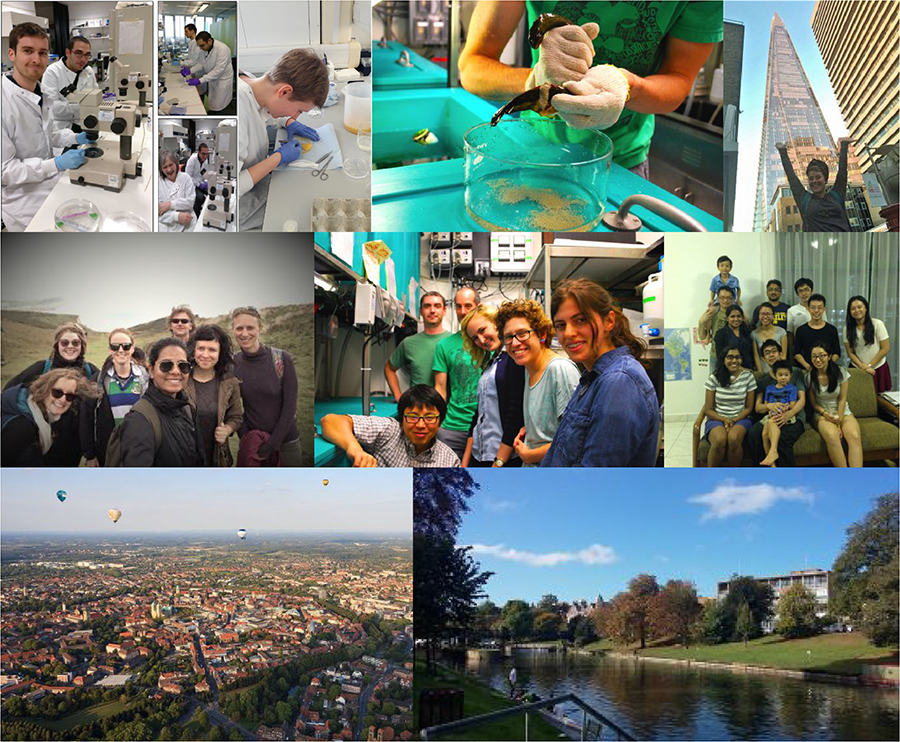Closing Date: 15 March 2021
The Section of Developmental Biology at the University of Colorado School of Medicine, with support from the Gates Frontiers Fund, is inviting applications for our Postdoctoral Training Program. Member labs in the program use diverse model systems to address a broad range of questions in the areas of Developmental Biology, Disease Modeling and Regenerative Medicine:
Bruce Appel, PhD, Professor and Diane G. Wallach Chair of Pediatric Stem Cell Biology; website: https://www.appellab.com
We investigate genetic, cellular and molecular mechanisms of neural development using zebrafish as a model system. In particular, we investigate how neural progenitor cells are specified for neuronal and glial cell fates and mechanisms that regulate myelin plasticity in response to brain activity.
- Ravanelli AM, and Appel, B. Genes & Development 29:2504-2515. PMCID: PMC4691953.
- Hughes, A. N. and Appel, B.bioRxiv 410969; doi: https://doi.org/10.1101/410969. Nature Communications (in press)
Emily Bates, PhD, Assistant Professor
The Bates lab uses human, mouse, and fly genetics to understand how cells coordinate to develop into complex structures like the human brain and face or a fly wing. Specifically, we are trying to understand how ion channels contribute to developmental signaling and how the cytoskeleton is regulated to build a brain.
- Dahal, GR, S. Pradhan, EA Bates. Development 2017 144:2771-2783. Doi:10.1242/dev146647. PMID: 28684627
- Belus, Matthew, Madison Rogers, Alladdin Elzubier, Josey, Megan, Rose, Steven, Bates, EA. Developmental BiologyDOI:10.1016/j.ydbio. PMID: 29571612
- Aiken, Jayne, Moore, J, Bates, EA. Human Molecular Genetics2018 doi:10.1093/hmg/ddy416. PMID: 30517687
Alexa Burger, PhD, Research Associate Professor
We use the zebrafish as our main model to understand the causes of congenital diseases affecting mesodermal organs. Our work combines gene-regulatory element discovery, genotype-phenotype association studies, and novel zebrafish-based models for pediatric diseases. We further develop new approaches for genome editing in zebrafish and beyond.
- D’Agati G, Cabello EM, Frontzek K, Rushing EJ, Klemm R, Robinson MD, White RM, Mosimann C, Burger A; Dis Model Mech. 2019 Jul 16;12(7). PMID: 31221659
- Burger A, Lindsay H, Felker A, Hess C, Anders C, Chiavacci E, Zaugg J, Weber LM, Catena R, Jinek M, Robinson MD, Mosimann C. Development. 2016 Jun 1;143(11):2025-37. PMID: 27130213
- Lindsay H, Burger A, Biyong B, Felker A, Hess C, Zaugg J, Chiavacci E, Anders C, Jinek M, Mosimann C, Robinson MD. Nat Biotechnol. 2016 Jul 12;34(7):701-2. PMID: 27404876
Peter Dempsey, PhD, Associate Professor
The Dempsey lab studies the development and function of epithelial cells in gastrointestinal tract during normal physiology and disease. In particular, we are interested in how extracellular signals regulate intestinal homeostasis and the role of cellular plasticity during intestinal regeneration and in colitis-associated cancer. We use genetically engineered mouse models and both adult and iPS-derived intestinal stem cell enteroid cultures to study these events.
- Jones JC, Brindley CD, Elder NH, Myers MG Jr, Rajala MW, Dekaney CM, McNamee EN, Frey MR, Shroyer NF, Dempsey PJ. Cell Mol Gastroenterol Hepatol. 2019;7(3):533-554
- Feng Y, Tsai YH, Xiao W, Ralls MW, Stoeck A, Wilson CL, Raines EW, Teitelbaum DH, Dempsey PJ. Mol Cell Biol. 2015 Nov;35(21):3604-21.
- Tsai YH, VanDussen KL, Sawey ET, Wade AW, Kasper C, Rakshit S, Bhatt RG, Stoeck A, Maillard I, Crawford HC, Samuelson LC, Dempsey PJ. Gastroenterology. 2014 Oct;147(4):822-834.
Caleb Doll, PhD, Research Assistant Professor
We study developmental myelination in zebrafish larvae, with focus on the mechanisms underlying local production of proteins in nascent myelin sheaths. We use cell type specific methods to visualize and manipulate RNA binding proteins and associated mRNA targets during oligodendrocyte development.
- Doll, C, Yergert, K, Appel, B. bioRxiv; doi: 10.1101/669895
- Doll, C,Vita, D, Broadie, K. Current Biology 27, 1–13;2017 Aug 7; https://doi.org/10.1016/j.cub.2017.06.046
Santos Franco, PhD, Assistant Professor and Boettcher Investigator; website:www.francolabcu.org
The Franco Lab uses mouse models to study several aspects of brain development. We are particularly interested in understanding early brain patterning, cell fate specification of neural stem cells, neuronal migration, dendrite formation and synaptogenesis.
- Winkler CC, Yabut OR, Fregoso SP, Gomez HG, Dwyer BE, Pleasure SJ, Franco SJ. (2018) J Neurosci. Jun 6;38(23):5237-5250. PMID: 29739868
• Fregoso SP, Dwyer BE, Franco SJ. (2019) Development. Mar 7;146(5). PMID: 30770393
• Gutierrez MA, Dwyer BE, Franco SJ. (2019) eNeuro. May 7;6(2). PMID: 31073541
Christian Mosimann, PhD, Associate Professor and Johnson Endowed Chair in Heart Development Research
Our lab studies the mechanisms of cell fate determination during development and congenital disease, with particular focus on the origins of mesodermal cell types and of the cardiovascular system. We combine transgenic, genome editing, single-cell, and live-imaging approaches using the zebrafish as our principal model and engage in several cross-species collaborations.
- Felker A, Prummel KD, Merks AM, Mickoleit M, Brombacher EC, Huisken J, Panáková D, Mosimann C.; Nat Commun.2018 May 21;9(1):2001. PMID: 29784942
- Cantù C, Felker A, Zimmerli D, et al.; Genes Dev. 2018 Nov 1;32(21-22):1443-1458. PMID: 30366904
- Prummel KD, Hess C, et al.; bioRxiv261115; doi: https://doi.org/10.1101/261115(accepted/in print)
Charles Sagerström, PhD, Professor
Our group uses zebrafish to study transcriptional and epigenetic control of key transitions during embryogenesis. We are particularly interested in understanding the onset of zygotic gene expression at the maternal-to-zygotic transition and in the initiation of neural gene expression in the embryonic ectoderm.
- S.-K. Choe, F. Ladam and C. G. Sagerström. Developmental Cell 28:203-211. PMID:24480644
- F. Ladam, W. Stanney III, I. J. Donaldson, N. Bobola and C. G. Sagerström. eLife2018;7:e36144. PMID: 29911973
Julie Siegenthaler, PhD, Associate Professor; website: www.siegenthalerlabcu.org
The Siegenthaler lab is focused on identifying cellular and molecular mechanisms regulating development and adult function of the CNS vasculature and the meninges. In pursuit of this goal, we utilize mouse genetics to specifically target meningeal and vascular cell populations and perturb signaling pathways of interest (retinoic acid, Wnt-beta-catenin), advanced imaging modalities, cell culture and transcriptional profiling. We have recently completed a first ever single cell transcriptome analysis of the developing meninges; this valuable tool will aid in studying the development of meningeal fibroblast populations and exploring interactions of fibroblasts with meninges-located vasculature and immune populations as well as the developing and adult CNS.
- Bonney, S, Dennison, BJC, Wendlandt, M, Siegenthaler, JA. Frontiers in Cellular Neuroscience,
- Mishra, S, Kelly, KK, Rumian NL, Siegenthaler, JA. Stem Cell Reports.
- DeSisto, J, O’Rourke, R, Bonney, S, Jones, HE, Guimiot, F, Jones, KL, Siegenthaler, JA. bioRxiv.
Kelly Sullivan, PhD, Assistant Professor and Boettcher Investigator
Our lab is interested in how an extra copy of chromosome 21 gives rise to the condition known as Down syndrome. We use a combination of primary samples, cell culture, and mouse models, to understand how aberrant interferon signaling affects development and contributes to pathophysiology in Down syndrome.
- Sullivan KD*, Lewis HC, Hill AA, Pandey A, Jackson LP, Cabral JM, Smith KP, Liggett LA, Gomez EB, Galbraith MD, DeGregori J, Espinosa JM*. Elife. PMID:27472900, PMCID: PMC5012864 *Co-corresponding Author
- Powers RK, Culp-Hill R, Ludwig MP, Smith KP, Waugh KA, Minter R, Tuttle, KD, Lewis HC, Rachubinski AL, Granrath RE, Carmona-Iragui M, Wilkerson RB, Kahn DE, Joshi M, Lleo A, Blesa R, Fortea J, D’Alessandro A, Costello JC, Sullivan KD*, Espinosa JM*. Biorxiv 403642 *Co-corresponding Author
The Training Program provides a mechanism for postdoctoral trainees to mature into successful independent researchers in Developmental Biology and Regenerative Medicine. Trainees are provided salary support in accordance with the NIH pay scale and the University of Colorado offers a full benefits package. Successful applicants will be appointed as Gates Fellows with initial appointments made for one year and continued support contingent on satisfactory progress. The Program also provides each trainee with a mentoring committee, funds to attend conferences/courses and networking opportunities in the form of interactions with visiting scientists, national/international collaborations, journal clubs, research interest groups and annual retreats. Interested trainees will also be given opportunities to teach and mentor students as well as to improve writing skills.
Applicants must have a PhD degree and less than two years of postdoctoral experience as of September 1, 2019. Interested candidates should submit 1) a statement explaining their interest in the Program and indicating their preferred host lab (2-page maximum), 2) a CV and 3) arrange to have three reference letters sent. Review of applications will begin immediately and finalists will be invited for on-campus interviews. We anticipate filling four positions and interviews will continue until the positions are filled.
Questions and applications should be submitted by email to Dr. Charles Sagerström, Director of the Postdoctoral Training Program, at charles.sagerstrom@cuanschutz.edu
 (No Ratings Yet)
(No Ratings Yet)
 Loading...
Loading...
 We look back over the first 20 episodes of Genetics Unzipped to select some of our favourite bits that you might have missed.
We look back over the first 20 episodes of Genetics Unzipped to select some of our favourite bits that you might have missed.

 (No Ratings Yet)
(No Ratings Yet)
 (1 votes)
(1 votes)